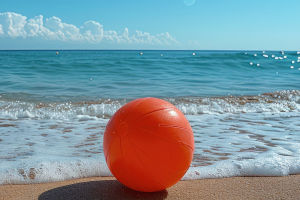Beach volleyball is a dynamic and passionate sport that originated on California beaches in the early 20th century.
It has gradually evolved into a global sporting activity that is not only popular on beaches around the world but also has become part of the Olympic Games.
Compared with traditional indoor volleyball, beach volleyball has many unique features and challenges that make it uniquely attractive in both competitiveness and viewing.
The court for beach volleyball is smaller than that for indoor volleyball, usually 16 meters long and 8 meters wide. Each team consists of two players, rather than six players as in indoor volleyball.
Due to the reduced number of players, players must move quickly across the court and take on more responsibilities such as attacking, defending, receiving, and serving.
The tacit understanding and cooperation between players are particularly important in this sport, as each player needs to be able to switch roles flexibly without substitutes to relieve pressure.
Another feature of beach volleyball is its field conditions. The softness of the sand increases the difficulty of the sport, and players must run and jump harder, this additional physical exertion also brings more challenges to the game.
At the same time, weather conditions, such as wind, sunshine, and temperature, also have an important impact on the game. The direction and strength of the wind may change the flight trajectory of the ball, while strong sunlight may affect the player's vision and judgment.
Therefore, beach volleyball players need to have good adaptability and quick reaction ability to cope with the ever-changing environment.
The rules of beach volleyball are somewhat different from those of indoor volleyball. The game adopts a three-set two-win system, with 21 points in each set and 15 points in the final set.
During the game, players can only play 7 points on one side of the court and then need to exchange courts to ensure that both sides can adapt to different environmental conditions. This frequent venue change increases the fairness of the game and adds a lot of exciting atmosphere for the audience.
Beach volleyball is very ornamental. It combines the speed, strength, and skills of sports competition and attracts a large number of spectators. The fast pace and tense situation of the game often make the audience involuntarily integrate into it, and the players' wonderful smashes, blocks, and saves become the highlights of the game.
Beach volleyball also has a strong entertainment and social atmosphere, especially in tropical areas, where the game is often combined with activities such as music, dance, and beach parties to form a unique beach culture.
Beach volleyball has also attracted much attention in the Olympics. Since it was first listed as an official event in the 1996 Atlanta Olympics, it has gradually become one of the most popular events in the Olympics.
Many world-class beach volleyball players, such as Kerri Walsh from the United States and Alison Cerutti from Brazil, have become legends of this event. Their outstanding performances have not only won honors for the country but also promoted the promotion of this sport worldwide.
Beach volleyball is no longer limited to the beach. Many cities' parks, fitness centers, and even indoor gymnasiums have begun to set up beach volleyball courts. Whether it is professional competition or amateur entertainment, beach volleyball brings people the joy of sports and the fun of socializing.
In the interweaving of sunshine, beach, and sweat, this sport exudes a unique vitality and charm, making it a favorite leisure and competitive event for people all over the world.


